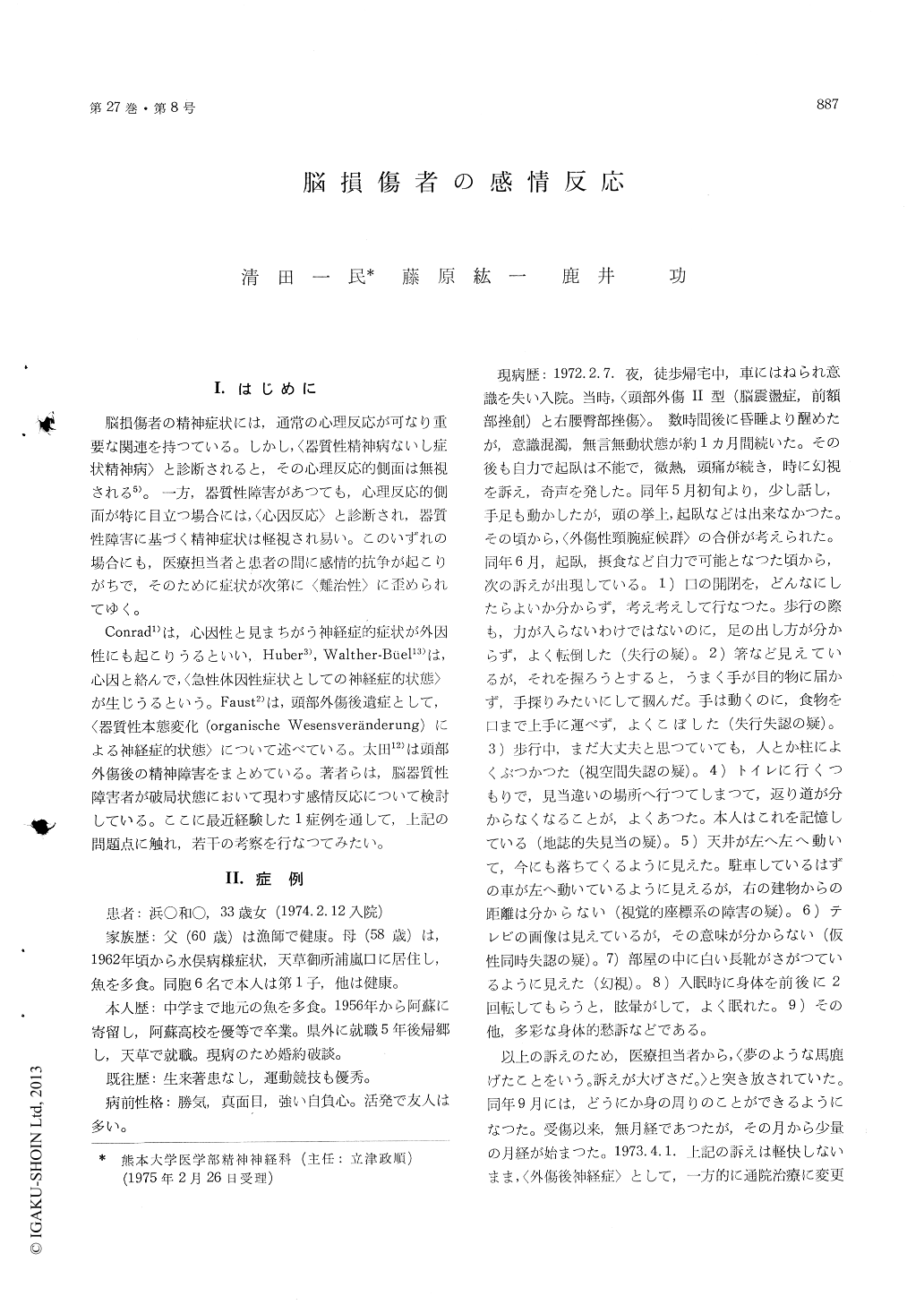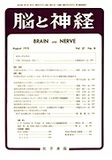Japanese
English
- 有料閲覧
- Abstract 文献概要
- 1ページ目 Look Inside
I.はじめに
脳損傷者の精神症状には,通常の心理反応が可なり重要な関連を持つている。しかし,〈器質性精神病ないし症状精神病〉と診断されると,その心理反応的側面は無視される5)。一方,器質性障害があつても,心理反応的側面が特に目立つ場合には,〈心因反応〉と診断され,器質性障害に基づく精神症状は軽視され易い。このいずれの場合にも,医療担当者と患者の間に感情的抗争が起こりがちで,そのために症状が次策に〈難治性〉に歪められてゆく。
Conrad1)は,心因性と見まちがう神経症的症状が外因性にも起こりうるといい,Huber3),Walther-Büel13)は,心因と絡んで,〈急性体因性症状としての神経症的状態〉が生じうるという。Faust2)は,頭部外傷後遺症として,〈器質性本態変化(organische Wesensveränderung)による神経症的状態〉について述べている。太田12)は頭部外傷後の精神障害をまとめている。著者らは,脳器質性障害者が破局状態において現わす感情反応について検討している。ここに最近経験した1症例を通して,上記の問題点に触れ,若干の考察を行なつてみたい。
A 33-year-old girl with traumatic mental sequelae 34 months after head injury was examined.
Somatic symptoms : Gait disturbances (atactic and slightly limping), geometric-optic dysgnosia, and related dyspraxia and acalculia, central vegetative dysregulation (such as vasomotor disturbance, strik-ing increase of puls frequency, hyperhidrosis, dis-turbances in thermoregulation, vegetative stomach and intestinal disturbances, and decrease in weight), abnormality of coenesthesis (such as strange, inde-finable paraesthetic sensations mixed with bizarre soreness, and feeling of sudden motor weakness), asymmetry of electroencephalogram (low voltage θ waves in the right parietal-occipital regions), group-ing voltage of electromyogram, and herniation of nucleus pulposus L4-5.
She showed several types of emotional reactions : catastrophic reaction (Goldstein), hypochondriac-depressive reaction, hysterical states, and anosognosia of atactic gait, which were different from purely psychogenic reaction, in being associated with focal or general signs of brain damage. A close relation of the emotional reactions and cerebral-organic signs was firstly concerned with disturbances in optic functions. Marked change of visual acuity with situations was resulted from geometric-optic dysgnosia, cerebral asthenopia, and narrow rangeof vision based on eye strain, so that she was confu-sed, and drived into catastrophic state. Secondarily, disturbances of optic and bodily axes caused sensori-motor induction syndrome (Halpern), such as past-walking to the left side, a tendency to fall, which was most conspicuous when optic control was eliminated, and dizziness and trembling induced by a glance at Archimedes' screw. Usually these signs were accompanied with confused emotional reactions. Thirdly, central vegetative dysregulation and ab-normality of coenesthesis produced hypochondriac-depressive state. Her emotional reactions differed from ordinary neurosis of covetousness and hysteria in the following aspects ; on one side she exaggerated her mental and physical troubles, on the other side, neglected a part of somatic signs, and integrated her defect.
The emotional reactions are considered to be produced by a causal correlation between the three factors : Psychological processes, somatic processes and endogenic conditions, such as age, sex, consti-tution, disposition, and intellect. Head injury be-comes simultaneously both the exogen-somatogenic and the exogen-psychogenic factors. The exogen-somatogenic factor directly acts on the somatic processes, producing focal and general lesions in the brain, or metabolic disturbances which hinder brain functions. The exogen-psychogenic factor works on the psychological processes, then indirectly on the somatic processes. The psychological and the somatic processes under the endogenic conditions build up catastrophic state, developing the emotional reactions.

Copyright © 1975, Igaku-Shoin Ltd. All rights reserved.


